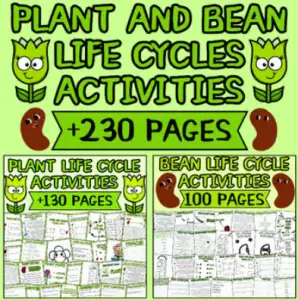Your cart is currently empty!
8 Spring Life Cycle Activities
Spring is the perfect season to bring the science of plant growth to life in your classroom. Teaching students about the plant and bean life cycles provides the perfect opportunity to combine hands-on learning with foundational science skills. Whether you’re working with kindergarteners or third graders, these spring-themed activities will make your life cycle lessons meaningful, memorable, and fun.
Here are engaging plant and bean life cycle activities you can easily incorporate into your spring science unit:
–Click here to access this resource.
1. Life Cycle Sequencing Activities
Help students visualize the stages of growth by using sequencing cards or cut-and-paste worksheets. Have them place each stage in order—from seed to mature plant or bean—and explain what happens at each step. This strengthens comprehension and supports vocabulary development.
2. Create a Life Cycle Craft
Add a creative twist with simple crafts like flower or bean wheel spinners, flipbooks, or foldable mini-books. These are perfect for interactive notebooks or bulletin board displays and give students a hands-on way to review the stages.
3. Label the Parts of a Plant and Bean
Introduce basic plant anatomy by having students label diagrams of plants and beans. Use visual aids and allow them to color each part, reinforcing terms like root, stem, leaf, and seed.
4. Compare and Contrast Plants and Beans
Encourage critical thinking by guiding students through a comparison of plant and bean life cycles. Use Venn diagrams or chart paper as a class to note the similarities and differences in growth stages and needs.
5. Cut-and-Paste Matching
Use printable worksheets where students match descriptions or pictures with the correct stage of the life cycle. This is a great activity for centers or independent work.
6. Reading and Writing Prompts
Integrate literacy with science by assigning short reading passages or writing prompts. Ask questions like “What does a bean need to grow?” or “Describe your favorite stage in the plant’s life cycle.” These activities boost comprehension and expressive language skills.
7. Word Tracing and Scramble Activities
Reinforce key vocabulary like “seed,” “sprout,” and “roots” with fun tracing and word scramble worksheets. These double as morning work or quick review activities.
8. Outdoor Observation Journal
If possible, take students outside to observe real plants or begin a small classroom growing project. Give them a simple journal to draw daily observations and track changes over time. This real-world connection deepens understanding and curiosity.
Wrap-Up Tip:
Mix and match these activities to fit your schedule and student needs. Whether you use crafts, cut-and-paste worksheets, or observational journals, your students will gain a deeper appreciation for the growth all around them during springtime.



Leave a Reply